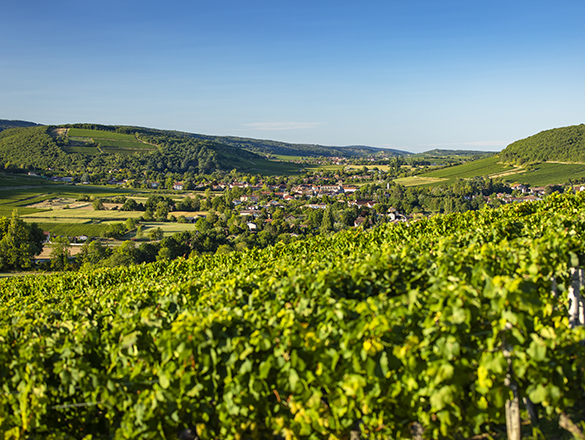
The vineyards of Bourgogne produce some great wines with a historical and international reputation. However, the region is not simply limited to its iconic appellations. In addition to its Village Premier Cru and Grand Cru AOCs, it also produces a range of wonderful Régionale and Village appellations to explore.
You will also find a full list of the Bourgogne’s Climats and lieux-dits on this page.
Check out the complete list of the 84 Bourgogne appellations.
However, your exploration has only just begun. Bourgogne wines have never before offered such high quality. Besides our range of internationally celebrated wines, try some of our lesser-known appellations where there are lots of surprises in store.
And for a fun way to find out more about the wines on offer, try out our “Which Bourgogne wine is right for me?” quiz, or check out Bourgogne Maps to take an interactive tour of the region.
Regional Appellation
VIGNOBLE DU MÂCONNAIS
31 juillet 1937
White: Chardonnay
Red and rosé: Gamay
Area under vine:
White: 74 hectares
Red and rosé: 16 hectares
Note: Average over three years 2016-2018
An additional geographical denomination that is part of the Régionale Mâcon appellation in the Mâconnais. According to the 2005 specifications rules, the name Mâcon-Azé refers to white, red, and rosé wines grown within a defined area in the village of Azé.

A beautiful golden yellow color, Mâcon-Azé whites have an intense, flattering nose marked by orchard fruits like peach, apricot, and quince, combined with hints of white blossom like acacia. They are lively on the attack and that sensation lingers in the mouth thanks to an acidulated framework that brings quite a long finish. They are fairly representative of these lovely Mâconnais wines that are both charming, indulgent, and forthright.
The reds, sometimes aged in oak, have an intense garnet color, reflecting a lovely concentration of berries, mainly in hotter years. The nose opens quickly with notes of blueberry and blackberry, and touches of jam. They are rounded in the mouth without any astringency.

White: With its sunny aromatic character and smoothness on the tongue, this wine makes a natural pairing with all kinds of goat cheeses, such as the traditional AOC Mâconnais or its neighboring Charolais for a terroir-themed aperitif. Follow with grilled chicken supremes or mixed fried river fish. This white wine will also bring out the best in local freshwater fish dishes, such as carp with white wine, or pochouse from Verdun-sur-le-Doubs.
Serving temperatures: 10-11°C as an aperitif, 11-12°C with food
Red: With its aromatic opulence and fleshy mouth, this wine is a remarkable companion with more fibrous meat dishes such as duck ravioli or braised côte de bœuf (ideally from Charolais). For wine-marinated dishes, choose a hot year such as 2018, which will help soften the acidity of the sauce in a bœuf bourguignon or a snail meurette. To finish a meal, try a washed-rind cow’s milk cheese that’s not too old, or something drier like a Palet de Bourgogne or a Cendré de Vergy, to match the freshness of the Gamay.
Serving temperature: 14-15°C

Along the valley of the Mouge, which for a while, shares the large valley of the Mâconnais running south-southwest/north-northeast, the vines of Azé spread out on either side of the slopes next to the Mâcon-Lugny appellation to the north and Mâcon-Igé to the south.
Like Solutré, Azé can legitimately claim to be an important site for geology and archaeology. Indeed, the caves of La Balme, which have been undergoing scientific exploration since 1920, are a special observation site for the Bourgogne sedimentary structure laid down during the Secondary era, 165 million years ago. The galleries contain traces of human occupation that are among the most ancient in the Bourgogne region, dating back to the Paleolithic, 300,000 years ago. Because this area was settled so early on and was well supplied with water - as the many mills and washing points serve to demonstrate - the area around Azé has long been highly prized, as demonstrated by the establishment of Roman and then aristocratic estates.
The cellars and the imposing presses of the Chateaux of Aine, Vaux-sur-Aine, and Montaigre serve as reminders of the landowning wealth of their former owners.

Clearly marked out between the lines of relief, the vines sit at between 250 and 440 meters above sea level, alongside the woods of Montagne de Rochebin (383 meters), Mont Pelé (411 meters), Normont (496 meters) and l’Atelier at 358 meters, to the east. The physical characteristics of the central Mâconnais, open to dominant north-south currents, results in mild temperatures and average rainfall of around 850mm annually.
Following the series of geological layers from the Middle and Upper Jurassic (between 150 and 170 million years ago) of the great Mâconnaise valley from west to east, the slopes alternate between limestone massifs and soft marl: Very pebbly, shallow, carbonate soil on the east-facing slopes (Les Platières), particularly good for growing Gamay; and clay-loam soils on a marl-limestone substrate on the other side of the slopes facing west (En Chatenay), and the midday sun, towards the hamlet of Conflans (the lieu-dit of Saint-Jean).
